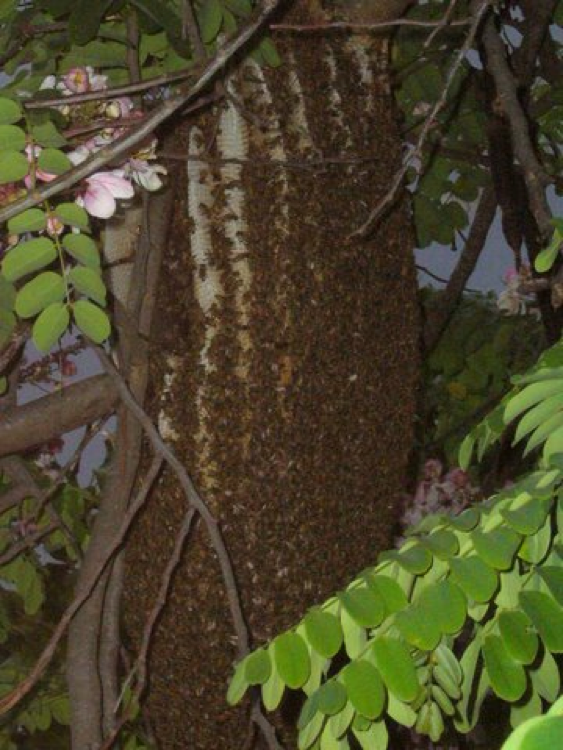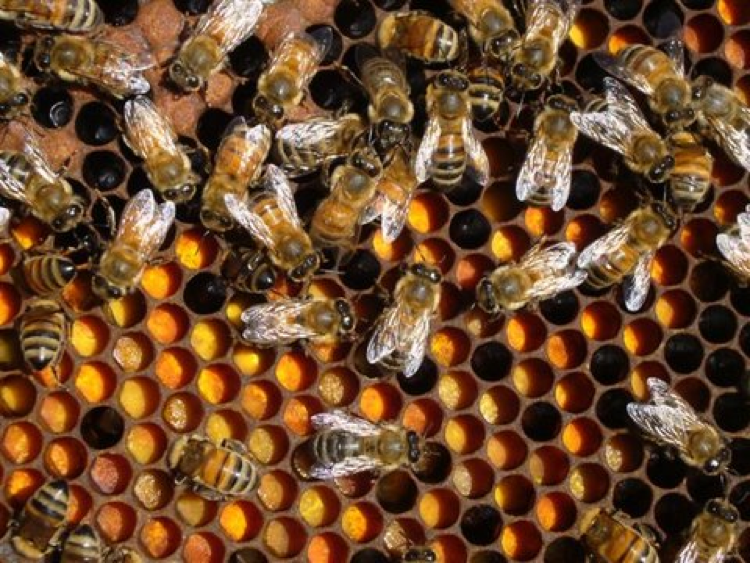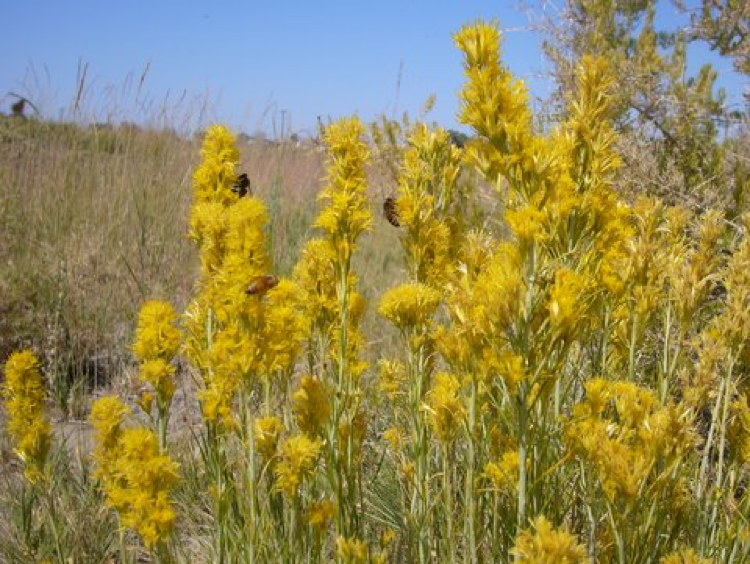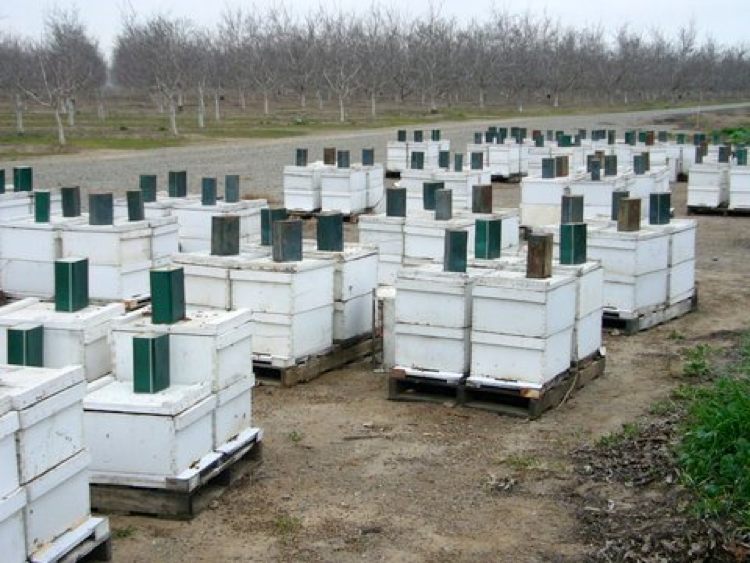An Adaptable Workforce
An Adaptable Workforce
Randy Oliver
ScientificBeekeeping.com
First published in American Bee Journal March 2010
I’d like to return to the analogy of the honey bee colony as being similar to a medium-sized mammal. The combs are analogous to the skeleton, the queen to the ovary, drones to sperms, honey to body fat, and the workers to the individual cells that make up organs.

The honey bee superorganism (minus the box). The wax combs are analogous to the skeleton of a heavy animal, the outer layer of water-shedding wings to the skin, and the various cohorts of workers within to the internal organs of a warm-blooded mammal. I took this photo in Gus Rouse’s Kona Queen yard in Hawai’i (all photos © the author).
The honey bee superorganism has one up on a mammal, though–a mammal can’t “dissolve” unneeded or overrepresented organs, and shift those cells to augment other organs. A colony of bees can—by shifting workers from one task to another. This plasticity in worker task specialization allows the colony to quickly respond to changes in the environment—such as a sudden bonanza of nectar, or the need to shift from broodrearing to winter cluster formation. However, in order to undergo such transformations at maximum efficiency, the individual bees of the colony must be able to share information. Such sharing is done via the commerce of foods (analogous to the mammal’s circulatory system), and through the bees’ pheromonal language (analogous to a colony nervous system).
Allow me to return to the concept of the hive economy, which is driven by floral resources, and to the female labor pool that processes them. (Drones do not participate in within-colony labor other than in heat production. That leaves the two castes of females—the queen or queens, whose only labor is to lay eggs, and the omnicompetent and versatile worker.) By having only one sort of generic yet adaptable worker, that can specialize in short order to fill any task, the colony’s workforce can rapidly shift from one job to another, as opportunities or challenges arise, so as to ensure that the economy of the hive functions most efficiently.
Seeley (1995) points out that much “communication” within the hive is by cues, rather than actual communicative signals. This is especially true with communicating the status of the state of nutrition within the hive. The feedback of cues (such as amount of jelly, or the ease of unloading nectar) forms the bulk of communication from the colony to the individual. Only a few signals (the dances, alarm and orientation pheromones, etc.) allow the individual to directly communicate to the colony as a whole.
Human economies adjust to respond to the dynamics of price—the more valuable goods get more economic attention. The same occurs in the hive—and foragers respond to cues that tell them how valuable certain commodities (rich or dilute nectar, water, or pollen) are at the moment. In response, the individual foragers invest work effort proportionally to the current value of each commodity, not for individual gain, but rather for the maximum gain of the colony as a whole.
Thus, a web of information sharing within the hive allows it to function without a central brain or government. Rather, the myriad feedback loops based upon food cues and pheromones allow the entire colony to act as a “mind” that allocates the labor pool to efficiently exploit the ever changing market of available resources upon which the hive economy is based—the pollen and nectar of the flowering plants that have coevolved in a mutually beneficial symbiosis with the bees. (Bees are the “shoppers” in the pollen market; plants advertise with bright petals and fragrant scent for bees to “buy” their product, and reward the shoppers with energy-rich nectar to fuel their shopping sprees.)
The godmother of hive dynamics was Dr. Anna Maurizio (1950), who found that workers in queenright colonies starved for pollen would transform into long-lived “winter” (diutinus) bees, even in summer. In the past several years the combined research of others has culminated in a considerable understanding of how nutrition and pheromonal feedback regulate colony economics and population dynamics.
Drs. Zachary Huang and Gene Robinson (1992, 1996) made a major breakthrough when they demonstrated, in a series of clever experiments, an antagonistic relationship in worker bees between two substances—juvenile hormone (JH) and vitellogenin (Vg). The relationship has been greatly expanded research by further research by the duo, and later by Drs. Gro Amdam, Robert Page, and their collaborators (Nelson 2007).
I’m going to try to simplify and summarize the current model for the dynamic interplay between colony protein economy and the allocation of the workforce into “winter,” nursing or foraging bees. In reality, there are multiple redundancies of feedbacks, stimuli, and inhibitors, but I feel that for Joe Beekeeper this simplified model will help us to understand the major forces at play. Let’s begin with vitellogenin.
POLLEN, VITELLOGENIN, AND JUVENILE HORMONE
The first thing to understand is that the requisite source of the protein necessary to build bee bodies is a nutritious mixture of pollens. Pollen is the most essential food for the colony, and is processed by nurse bees into vitellogenin (Vg), which can then either be stored in the fat bodies (in “winter” bees) or converted into jelly (by nurse bees) for transfer to the queen, brood, and foragers.
Bees with high Vg titers remain in a “young” state, and rarely leave the hive. The presence of high levels of Vg in their “blood” (haemolymph) suppresses the action of the hormone that causes them to “age” into foragers—juvenile hormone (which surprisingly has the opposite action in bees that it does in “normal” insects).
When fresh pollen is in short supply in the immediate broodnest, colony Vg levels drop, which then allows JH levels to rise, thus causing middle-aged (or even young bees during severe famine) to quickly “age” into foragers, with a disposition to collect pollen in preference to nectar. This feedback loop adjusts the relative amounts of brood, nurses, and foragers in a colony.
This colony has abundant mixed pollens in the broodnest, young “wet” brood, and appears to be in nutritional balance. Note the bees engaged in trophallaxis—the exchange of pheromones and food.
Practical application: colony buildup is largely dependent upon an uninterrupted supply of fresh pollen immediately around the brood. A colony can lose the “momentum” of its buildup during a short pollen dearth.
Be aware that a strong broodrearing colony can eat up all its pollen reserves during a few days of rainy weather (and even cannibalize brood). Supplemental protein feeding can mitigate the effects of the resultant pollen shortage, or promote broodrearing at times when natural pollen is scarce (as before almond bloom, or during late summer).
At this point, since I suspect that some of your brains are already starting to fog from the flurry of jargon, I’ve drawn up a visual chart for you to refer to.
A summary of the physiological changes in the colony workforce as they “age” through a series of behavioral tasks. Note the plasticity of bees in that they can sometimes “revert” to a previous task if necessary.
Amdam (2004 and pers. comm.) and others (Lourenco 2009) have found that not only do forager bees have reduced immune function due to low Vg levels, but that young bees that become infested with parasites (get sick) apparently deplete their Vg stores in the process of mobilizing their immune system. Ditto with stressed bees (Lin 2004). This then removes Vg’s inhibitory effect toward JH, and the sick bees quickly transition to foraging behavior. This process has major implications in the understanding of colony-level immune function. First, it gets sick bees out of the nursery, and second, it helps to explain the reason that parasites (including viruses) that attack adult bees can quickly depopulate a colony (I will return to this in an upcoming article).
Practical application: starved, stressed, or infected bees can very quickly shift to forager status. By doing so, they rapidly begin to age, and are soon lost to the colony. Younger bees then take their places. If the infection is not brought under control, especially if nutrition is poor, this process can rapidly depopulate a colony—leaving only the queen and a handful of young (uninfected) workers. Sound familiar?
Practical tip: colonies in late summer following poor forage conditions may be composed largely of undernourished older bees with poor immune function. Such bees are sitting ducks waiting to be knocked off by varroa and viruses.
Drs. Heather Mattila and Gard Otis (2007a, b) recently fit some final pieces into this jigsaw puzzle by studying the transition of a colony to “winter” bee status. The common wisdom has been that colonies shut down brood rearing in response to shorter days and cool weather, and resume it when days begin to get longer. However, there is virtually no actual evidence to support that those factors (temperature or photoperiod) are causal, as opposed to coincidental. What Mattila and Otis demonstrated was that it was the cessation of pollen income that initiated the suspension of broodrearing, which was then the reason for the last emerging brood developed into “winter” bees. Feeding of pollen supplement late in fall prolonged broodrearing, but didn’t increase the size of the eventual winter cluster.
As much as I’d love to say that everything is now explained neat and tidy, the authors express a caveat:
“It is unlikely that the availability of pollen is the only trigger that induces the switch from brood-filled colonies of short-lived workers to broodless colonies of long-lived workers because seasonal changes in pollen supply clearly do not account for the resumption of brood rearing that occurs before workers start foraging in spring. It would be adaptive for colonies to utilize several redundant cues to initiate this switch during autumn, because having a single mechanism would result in opportunities for mistakes as they prepare to survive a long winter, one of the most severe environmental challenges that honeybee colonies face in temperate environments.”
Mattila and Otis found that fall feeding was not of benefit in Guelph, Ontario. It is of practical interest whether their findings apply to say, colonies going to almond pollination in California. I studied their paper, and compared it to my own practical experience, and to the data gathered by Dr. Frank Eischen in California (in prep), which indicate a contrary conclusion.
One huge difference is the massive amount of pollen coming into the Guelph colonies in fall—the colonies with pollen traps yielded an average of 13 lbs of pollen in the last two months (Sept and Oct) of flight. Assuming that 50% of the pollen got through the traps, that means that even the “pollen-limited” colonies were able to obtain about 13 lbs of pollen despite being trapped. I’ll tell you right now that any beekeeper in California whose colonies each got 13 pounds of natural pollen in fall would be one happy camper!
Bees on Rabbitbrush (Chrysothamnus) in Nevada. Many Western beekeepers rely upon this plant as a fall source of pollen. Rabbitbrush bloom was killed by early frost this year in some areas, and the bees suffered for lack of late pollen.
Second, the winter temperatures are significantly colder in Guelph than they are in most of California. In many of the Pacific overwintering areas, colonies only form tight clusters on occasion, since even in winter the daily high temperature often allows the breaking of the cluster and bee flight (the average January high temperature for Modesto is 54°F). So I’m not clear what percentage of bees go into true diutinus state during California winters.
Indeed, in a recent presentation, Dr. Eischen showed that colonies destined for almond pollination, and wintered in the cold mountains of California behaved very differently than those wintered at a warmer lower elevation. The mountain colonies appeared to have formed true winter clusters, suspended broodrearing for a longer period, and had less adult bee loss. Once moved to the orchards, the mountain-wintered bees not only caught up with, but passed, the lowland bees once the almond bloom was underway.
I’ve looked carefully at the data from Mattila and Otis (2007a) and Harris (2008) regarding the formation of “winter” bees. One thing that jumps out at me is that few bees that actually engaged in broodrearing as nurses later became long-lived “winter” bees. The long-lived bees were mostly those that emerged after the last brood was sealed. Such bees would have had pollen resources in order to develop plenty of stored protein in their fat bodies, haemolymph, and hypopharyngeal glands, but would never have fed any jelly to brood (I’ll cover the trigger for their transition to “winter” bees in my next article).
Colonies being fed on the Sacramento Valley floor prior to almond bloom. The syrup feeding helps to stimulate broodrearing, but may also cause workers to wear themselves out in fruitless foraging. Unless these hives have good pollen stores from the previous fall, they will be lacking in the protein necessary for good buildup, due to inadequate local forage at this time of year.
So let’s try to make sense of this. Honey bees have this survival mechanism to deal with pollen dearths: they shut down broodrearing when pollen runs out (perhaps even cannibalizing brood), and give what protein they’ve got to the oldest larvae. At that point, the colony is sitting on its future—the sealed brood that will emerge over the next twelve days. It’s not clear yet whether the last of the former nurses transfer their remaining protein reserves to the emerging bees, but somehow those bees wind up with high Vg levels. They will have no brood to feed, and will become long-lived diutinus bees prepared to survive after all the rest of the bees in the colony have perished in the search for food, succumbed to disease, or simply flown their aging bodies out to die away from the hive.
This shrewd strategy removes any excess mouths to feed during time of dearth, and ensures that fresh, “fat,” unworn bees are given the responsibility to hold down the fort. As long as they have some sort of honey reserves, they can survive through winter cold or summer drought until the next pollen flow.
As far as practical application of this knowledge, it is all about local conditions and timing. Research suggests the following management actions:
Cold winter areas with late pollen flows: fall supplemental feeding (of protein) may not be of benefit—it just prolongs broodrearing. Save your money for appropriately-timed spring feedings if bees don’t get early pollen flows. This will help them to build so as to take advantage of early nectar flows—if they have to wait until the nectar flow to build up, you won’t make near the honey crop that you could have!
Cold winter areas without late pollen flows: feed pollen supplement in late summer, timed to allow the colony to produce a late round of brood that will be emerging as cold weather shuts down foraging.
For almond pollinators with bees in holding yards with little natural forage:
California wintering (in mild winter areas): Eischen’s research in California suggests starting protein feeding no later than September, and continually through until bloom (many top-notch California beekeepers begin feeding in August). Colonies will take less supplement in November and December. Don’t forget to give the colonies a patty if they are sitting very long in the orchards before bloom–lack of protein at that critical time can shut down their buildup.
California wintering (in cold winter areas or sheds): Feed if appropriate in fall, and then let the colonies settle down into “winter” mode for minimal adult mortality. Due to the resultant larger surviving cluster size, such colonies can catch up with colonies that were overwintered at lower elevation, despite the lowland bees’ head start in broodrearing. I find that strong, heavy colonies that were on good fall pollen flows don’t need any additional help. However, January feeding of pollen supplement will enable them to build to splittable size before bloom!
Southern wintering: if your colonies aren’t in great shape in fall, it may be worthwhile to “skip winter” entirely by moving hives to the warm south to build up on natural forage, and then move them to California at the last moment.
Syrup: all the above assume that colonies have plenty of honey or heavy syrup stores. Colonies without ample honey stores are loathe to winter with large clusters. Feeding of light syrup (especially sucrose) will stimulate broodrearing.
Coming Up
The primer pheromones and managing the labor pool.
References
Amdam, GV, et al (2004) Hormonal control of the yolk precursor vitellogenin regulates immune function and longevity in honeybees. Experimental Gerontology 39 (2004) 767–773.
Harris, JL (2008) Development of honey bee colonies initiated from package bees on the northern Great Plains of North America. Journal of Apicultural Research and Bee World 47(2): 141–150.
Huang, Z and GE Robinson (1992) Honeybee colony integration: Worker-worker interactions mediate hormonally regulated plasticity in division of labor. Proc. Natl. Acad. Sci. 89: 11726-11729.
Huang, Z and GE Robinson (1996) Regulation of honey bee division of labor by colony age demography. Behav Ecol Sociobiol (1996) 39 : 147–158.
Lourenço AP, Martins JR, Bitondi MMG, Simões ZLP.(2009) Trade-off between immune stimulation and expression of storage protein genes. Arch Insect Biochem Physiol. 71(2): 70-87.
Nelson CM, Ihle KE, Fondrk MK, Page RE Jr, Amdam GV (2007) The Gene vitellogenin Has Multiple Coordinating Effects on Social Organization . PLoS Biol 5(3): e62. doi:10.1371/journal.pbio.0050062
Lin HR, Dusset C, Huang ZY (2004) Short-term changes in juvenile hormone titers in honey bee workers due to stress. Apidologie 35: 319–327.
Mattila HR, Otis GW (2007a) Dwindling pollen resources trigger the transition to broodless populations of long lived honeybee each autumn. Ecol Entomol 32:496–505.
Mattila HR, Otis GW (2007b) Manipulating pollen supply in honey bee colonies during the fall does not affect the performance of winter bees. Canadian Entomol. 139: 554-563.
Maurizio A (1950) The influence of pollen feeding and brood rearing on the length of life and physiological condition of the honeybee: preliminary report. Bee World 31:9–12
Seeley, T.D. (1995) The Wisdom of the Hive. Harvard Univ. Press







